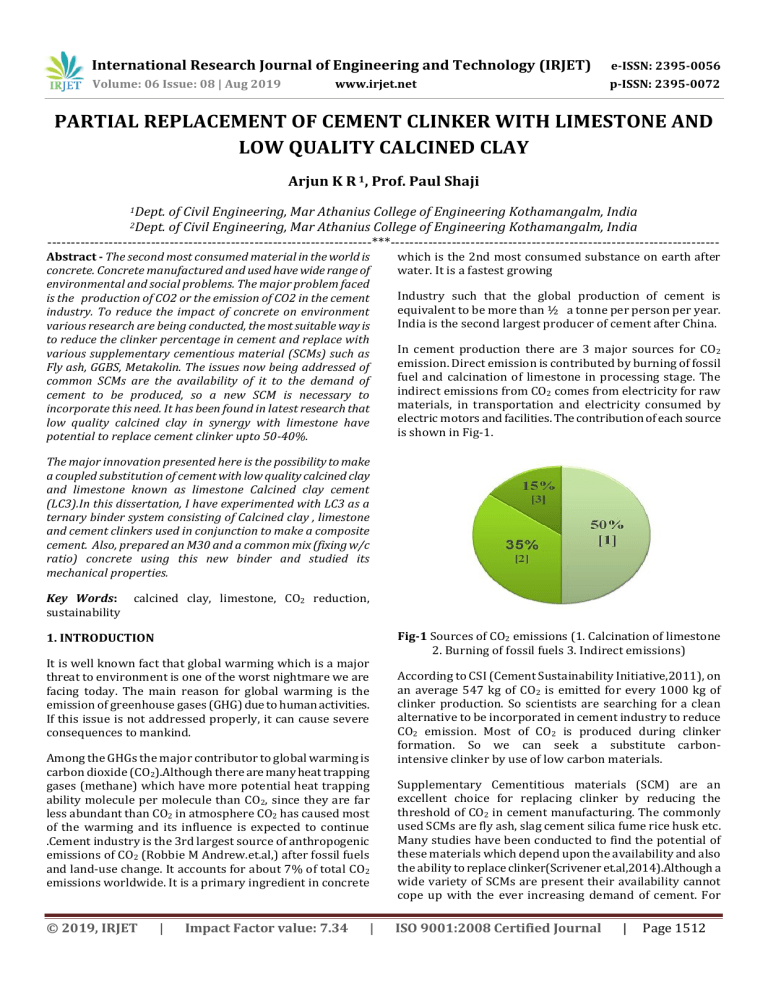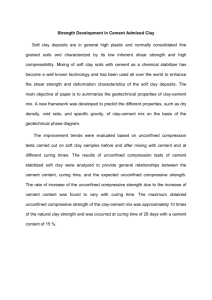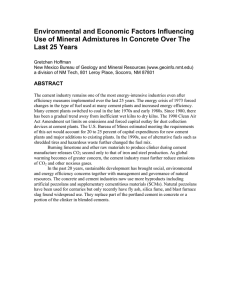IRJET-Partial Replacement of Cement Clinker with Limestone and Low Quality Calcined Clay
advertisement

International Research Journal of Engineering and Technology (IRJET) e-ISSN: 2395-0056 Volume: 06 Issue: 08 | Aug 2019 p-ISSN: 2395-0072 www.irjet.net PARTIAL REPLACEMENT OF CEMENT CLINKER WITH LIMESTONE AND LOW QUALITY CALCINED CLAY Arjun K R 1, Prof. Paul Shaji 1Dept. of Civil Engineering, Mar Athanius College of Engineering Kothamangalm, India of Civil Engineering, Mar Athanius College of Engineering Kothamangalm, India ---------------------------------------------------------------------***---------------------------------------------------------------------2Dept. Abstract - The second most consumed material in the world is concrete. Concrete manufactured and used have wide range of environmental and social problems. The major problem faced is the production of CO2 or the emission of CO2 in the cement industry. To reduce the impact of concrete on environment various research are being conducted, the most suitable way is to reduce the clinker percentage in cement and replace with various supplementary cementious material (SCMs) such as Fly ash, GGBS, Metakolin. The issues now being addressed of common SCMs are the availability of it to the demand of cement to be produced, so a new SCM is necessary to incorporate this need. It has been found in latest research that low quality calcined clay in synergy with limestone have potential to replace cement clinker upto 50-40%. which is the 2nd most consumed substance on earth after water. It is a fastest growing Industry such that the global production of cement is equivalent to be more than ½ a tonne per person per year. India is the second largest producer of cement after China. In cement production there are 3 major sources for CO2 emission. Direct emission is contributed by burning of fossil fuel and calcination of limestone in processing stage. The indirect emissions from CO2 comes from electricity for raw materials, in transportation and electricity consumed by electric motors and facilities. The contribution of each source is shown in Fig-1. The major innovation presented here is the possibility to make a coupled substitution of cement with low quality calcined clay and limestone known as limestone Calcined clay cement (LC3).In this dissertation, I have experimented with LC3 as a ternary binder system consisting of Calcined clay , limestone and cement clinkers used in conjunction to make a composite cement. Also, prepared an M30 and a common mix (fixing w/c ratio) concrete using this new binder and studied its mechanical properties. Key Words: sustainability calcined clay, limestone, CO2 reduction, 1. INTRODUCTION It is well known fact that global warming which is a major threat to environment is one of the worst nightmare we are facing today. The main reason for global warming is the emission of greenhouse gases (GHG) due to human activities. If this issue is not addressed properly, it can cause severe consequences to mankind. Among the GHGs the major contributor to global warming is carbon dioxide (CO2).Although there are many heat trapping gases (methane) which have more potential heat trapping ability molecule per molecule than CO2, since they are far less abundant than CO2 in atmosphere CO2 has caused most of the warming and its influence is expected to continue .Cement industry is the 3rd largest source of anthropogenic emissions of CO2 (Robbie M Andrew.et.al,) after fossil fuels and land-use change. It accounts for about 7% of total CO2 emissions worldwide. It is a primary ingredient in concrete © 2019, IRJET | Impact Factor value: 7.34 | Fig-1 Sources of CO2 emissions (1. Calcination of limestone 2. Burning of fossil fuels 3. Indirect emissions) According to CSI (Cement Sustainability Initiative,2011), on an average 547 kg of CO2 is emitted for every 1000 kg of clinker production. So scientists are searching for a clean alternative to be incorporated in cement industry to reduce CO2 emission. Most of CO2 is produced during clinker formation. So we can seek a substitute carbonintensive clinker by use of low carbon materials. Supplementary Cementitious materials (SCM) are an excellent choice for replacing clinker by reducing the threshold of CO2 in cement manufacturing. The commonly used SCMs are fly ash, slag cement silica fume rice husk etc. Many studies have been conducted to find the potential of these materials which depend upon the availability and also the ability to replace clinker(Scrivener et.al,2014).Although a wide variety of SCMs are present their availability cannot cope up with the ever increasing demand of cement. For ISO 9001:2008 Certified Journal | Page 1512 International Research Journal of Engineering and Technology (IRJET) e-ISSN: 2395-0056 Volume: 06 Issue: 08 | Aug 2019 p-ISSN: 2395-0072 www.irjet.net example slag can replace clinker by 70% but only 5% is available and is not sufficient for cement production .Although fly ash is available in abundant it can reduce the quality of cement so the replacement percentage is kept as low as 30%. The availability of common SCMs are shown in Fig-2. So we need new alternatives that can cope up with the cement demand, with low cost and can be incorporated in the industry without much changes in the design and construction and faster implementation in practice with minimum training to workers. Clays are found abundant in nature and has worldwide distribution. They become reactive at temperature 600-850oC which is far more less the calcination temperature of clinker formation which is 1450oC. They have been used as SCM for a long time but their replacement is as less as fly ash i.e 30%. Recent studies show that by combining limestone with calcined clay, the properties of clay can be enhanced. Limestone react with alumina in presence of calcium hydroxide. (S.Sanchez.Berriel et.al, 2016). Calcined clay enhances the reaction by providing extra alumina.Carbo alumina hydrates are formed and fill the pore spaces which will increase the strength. The equation is shown. 2. EXPERIMENTAL PROCEDURES The methodology and the procedures used are 2.1 Materials Ordinary Portland cement (OPC) of grade 53 was used which confirms to IS2269, specific gravity of cement was found to be 3.15 and initial and final setting time being 44 minutes and 348 minutes. The material properties is listed out in table 4. Limestone of two different qualities were used and is denoted as L1 and L2 , in which L2 is a superior quality limestone as compared to L1, composition of the material is provided in the table 2. Portland pozzlana cement containing 20% flyash was used and is denoted as PPC, specific gravity of the cement was found to be 2.82 and the initial and final setting time as 130 minutes and 240 minutes. Calcined clay containing a kaolin content of 50% was used in the experiments it was obtained from EICL Trivandrum, the detail composition is mentioned in table 2. Coarse aggregate and fine aggregate confirming to zone II is used for the experiment .High performance super plasticizer based on polycarboxylic ether was used (MasterGlenium SKY8233) for test. Table 1: PROPERTIES OF FINE AND COARSE AGGREGATES USED A(from calcined clay) + Cc+3CH---------> C3A-Cc-Hh This ternary blend of limestone, calcined clay and clinker is called LC3 which is on its way to prove its potential in the cement industry by addressing the twin issues of CO2 emissions and saving natural resources.(Antoni et.al,2012).The clay used is low quality clay. Among the various clay minerals, kaolin has the highest pozzolanic activity (Siber et.al,).As kaolin increases the reactivity of clay also increases. Any clay containing more than 40% kaolin is found to have excellent properties (Amritpa Kaur et.al, 2015)and when this clay is heated the kaolin turns into metakaolin This paper focuses on the emerging technology LC3 which is the calcinated clay in combination with limestone for partial replacement of clinker. Property Specific gravity Bulk density Fineness modulus Water absorption Grading zone Effective size- D10 Fine aggregate 2.59 1.31g/cc 3.476 0.6% Zone II 0.155 Coarse aggregate 2.69 1.59g/cc 4.309 1.3% 15.523 Table 2: COMPOSITION OF MATERIALS Component OPC Calcined clay SiO2 CaO MgO Al2O3 Fe2O3 K2O Na2O 20.2 64.8 2.26 3.81 4.65 0.43 0.67 42.20% 4.02% 31.8% 2.3% - Limestone L1 L2 15.2% 20.6% 30.8% 41.6% - 3. METHODOLOGY First the material properties of different materials were tested, the next stage was to fix the optimum dosage till which calcined clay could be substituted, for getting the optimum dosage of calcined clay, mortar compressive strength of 3, 7, 28 day were found out for different proportions of calcined clay by keeping the limestone dosage constant at 15%, the different proportions adopted for Fig-2 Availability of common SCMs © 2019, IRJET | Impact Factor value: 7.34 | ISO 9001:2008 Certified Journal | Page 1513 International Research Journal of Engineering and Technology (IRJET) e-ISSN: 2395-0056 Volume: 06 Issue: 08 | Aug 2019 p-ISSN: 2395-0072 www.irjet.net testing is mentioned in Table 3. Calcined clay, limestone and cement are dry mixed in the digi mortar mixer for 3 minutes first at a lower RPM for 2 min and then at higher RPM for 1 minute. Two potential mix were selected based on the maximum strength attainment with comparison that of OPC mortar cube strength and maximum percentage of replacement , the two mix is denoted as LC1a and LC2a, suitable super plasticizer is found out and the optimum percentage of super plasticizer is found by marsh cone test similar test are conducted for OPC and PPC .Based on the available data M30 design for LC1, LC2, OPC and PPC is made and the compressive strength after 3 , 7 and 28 day curing are found out. Similarly design is also made by replacing L1 to L2 in LC1 and LC2 and is denoted as LC1b and LC2b. Table 3: BLENDING PROPORTIONS Blends Cement + Gypsum 100 55 50 45 OPC LCi LCii LCiii Calcined clay 30 35 40 5.RESULTS 5.1 Compressive strength By testing mortar cube strength it can be seen in Fig. 3 the maximum strength attainment is seen at, replacement of 30% calcined clay, further increase in calcined tends to decrease the compressive strength but are comparable to that of OPC at 35% replacement. For compressive strength a total of 54 cubes were casted. The compressive strength 3 day, 7 day and 28 day were tested, it was seen that the mix containing superior quality of limestone (LC1b) out performed than any other mix. For other mixes the compressive strength was comparable to that of OPC. The initial and median strength development is higher for LC blends compared to that of PPC. limestone 15 15 15 15 Table 4: PROPERTIES OF CEMENT Properties specific gravity standard consistency initial setting time final setting time OPC 3.15 31% PPC 2.82 31% LC3 3.12 37% 44 130 98 348 340 410 Fig.3: Compressive strength of mortar cubes Table 5: MIX PROPORTIONS MIX name w/b Cement (kg) Water (Liter) Coarse (Kg) Fine (Kg) OPC LC1a LC1b LC2a LC2b 0.45 0.45 0.45 0.45 0.45 350 350 350 350 350 157 157 157 157 157 1238 1236 1236 1234.7 1234.7 706 704.4 704.4 703.6 703.6 S dosage (%) 0.2 0.44 0.44 0.5 0.5 4.COMPRESSIVE STRENGTH Mortar cubes mould of 7.07 x 7.07 x 7.07 cm was used for determining mortar cube strength at 3 day, 7 day and 28 day. Concrete cubes of size 150x150x150 cm were prepared for determining the compressive strength of different mix. Concrete cubes after respecting curing period 3, 7 and 28 day were tested under the compressive testing machine of 5000kN capacity © 2019, IRJET | Impact Factor value: 7.34 | Fig 4. Compressive strength of cubes 6. DISSCUSION OPC and LC3 develops comparable strength and in LC3 containing superior quality of limestone shows higher strength to that of OPC. ISO 9001:2008 Certified Journal | Page 1514 International Research Journal of Engineering and Technology (IRJET) e-ISSN: 2395-0056 Volume: 06 Issue: 08 | Aug 2019 p-ISSN: 2395-0072 www.irjet.net 8. In 3 day, 7 day and 28 day LC3 develops much higher strength to that of PPC. Optimum dosage being ,30% calcined clay, 15% limestone and 5% gypsum ,higher substitution of 35% also shows comparable strength development The mix is found to be more workable in LC2 case than OPC , it’s due to the lower water absorption of LC2 When comparing with OPC and PPC, LC3 can be developed at a much cheaper cost as, the raw material required is cheaper and calcination procedure requires a much lower temperature than cement clinkerziation Better quality of limestone increases the strength attainment at faster rate. ACKNOWLDGEMENT Ferreiro, S., Herfort, D., & Damtoft, J. S. (2017). Cement and Concrete Research E ffect of raw clay type, fineness, water-to-cement ratio and fly ash addition on workability and strength performance of calcined clay – Limestone Portland cements. Cement and Concrete Research, 0–12. 9. Handapani, Y., Sakthivel, T., Santhanam, M., Gettu, R., & Pillai, R. G. (2018). Cement and Concrete Research Mechanical properties and durability performance of concretes with Limestone Calcined Clay Cement (LC 3). Cement and Concrete Research, 107,136–151. 10. S, Sanchez Berriel, A.Favier, E Rosa Dominguez, and k S. (2016). Assessing the environmental and economic potential of Limestone Calcined Clay Cement in Cuba. Cleaner Production, 124(2016), 361–369. 11. Avet, F., & Scrivener, K. (2018). Investigation of the calcined kaolinite content on the hydration of Limestone Calcined Clay Cement (LC3). Cement and Concrete Research, 107,124–135. I express my deep sense of gratitude to my guide Prof. Paul Shaji, Professor, Department of Civil Engineering, for his help, advice, support, constant encouragement and valuable guidance REFERNCES 1. Andrew, Robbie M. "Global CO 2 emissions from cement production." Earth System Science Data 10.1 (2018): 195 2. Scrivener, K., Martirena, F., Bishnoi, S., & Maity, S. (2017). Cement and Concrete Research Calcined clay limestone cements (LC 3). Cement and Concrete Research, 1–15. 3. Berriel, S. Sánchez, et al. "Assessing the environmental and economic potential of Limestone Calcined Clay Cement in Cuba." Journal of cleaner Production 124 (2016): 361-369. 4. Antoni, M., Rossen, J., Martirena, F., & Scrivener, K. (2012). Cement substitution by a combination of metakaolin and limestone. Cement and Concrete Research, 42(12), 1579–1589. Sabir, B. B., Wild, S., & Bai, J. (2001). Metakaolin and calcined clays as pozzolans for concrete : a review. Cement and Concrete Composites, 23(2001), 441– 454. Maity, S., Bishnoi, S., & Kumar, A. (n.d.). Field Application of Limestone-Calcined Clay Cement in India, 435–441. Mathieu, A., Alujas, A., & Martirena, F. (2017). Industrial calcination of kaolinitic clays to make reactive pozzolans. Case Studies in Construction Materials, 17, 1–15 5. 6. 7. © 2019, IRJET | Impact Factor value: 7.34 | ISO 9001:2008 Certified Journal | Page 1515


